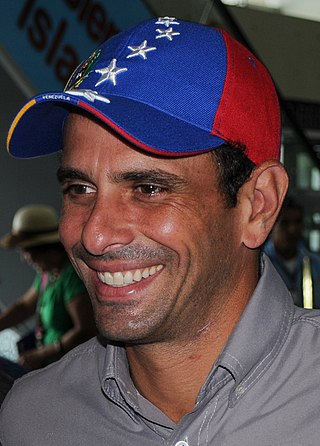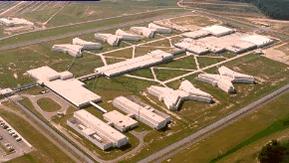Related Research Articles
A prison riot is an act of concerted defiance or disorder by a group of prisoners against the prison administrators, prison officers, or other groups of prisoners.

Henrique Capriles Radonski is a Venezuelan politician and lawyer, who served as the 36th Governor of Miranda from 2008 to 2017.

Presidential elections were held in Venezuela on 7 October 2012 to choose a president for a six-year term beginning in January 2013.

The Apodaca prison riot occurred on 19 February 2012 at a prison in Apodaca, Nuevo León, Mexico. Mexico City officials stated that at least 44 people were killed, with another twelve injured. The Blog del Narco, a blog that documents events and people of the Mexican Drug War anonymously, reported that the actual (unofficial) death toll may be more than 70 people. The fight was between Los Zetas and the Gulf Cartel, two drug cartels that operate in northeastern Mexico. The governor of Nuevo León, Rodrigo Medina, mentioned on 20 February 2012 that 30 inmates escaped from the prison during the riot. Four days later, however, the new figures of the fugitives went down to 29. On 16 March 2012, the Attorney General's Office of Nuevo León confirmed that 37 prisoners had actually escaped on the day of the massacre. One of the fugitives, Óscar Manuel Bernal alias La Araña, is considered by the Mexican authorities to be "extremely dangerous," and is believed to be the leader of Los Zetas in the municipality of Monterrey. Some other fugitives were also leaders in the organization.
The Altamira prison brawl was a deadly fight that occurred on 4 January 2012 in Altamira, Tamaulipas, Mexico. Officials from the state of Tamaulipas confirmed that 31 people were killed, with another thirteen injured. The fight started after a drug gang burst into a section of the prison where they were banned from, attacking their rival gang housed there, triggering the fight. During the altercation, the inmates used several kinds of cold weapons (non-firearms) to kill their opponents. The prisoners also used sticks and knives to massacre the members of the rival gang.
Crime in Venezuela is widespread, with violent crimes such as murder and kidnapping increasing for several years. In 2014, the United Nations attributed crime to the poor political and economic environment in the country—which, at the time, had the second highest murder rate in the world. Rates of crime rapidly began to increase during the presidency of Hugo Chávez due to the institutional instability of his Bolivarian government, underfunding of police resources, and severe inequality. Chávez's government sought a cultural hegemony by promoting class conflict and social fragmentation, which in turn encouraged "criminal gangs to kill, kidnap, rob and extort". Upon Chávez's death in 2013, Venezuela was ranked the most insecure nation in the world by Gallup.
On 25 January 2013, a riot began at Uribana prison in Barquisimeto, Venezuela. Initial reports gave at least 50 people killed and over 120 people injured, and by 27 January a death toll of 61 was reported. Officials on the first day of the riot faulted media for breaking news in advance that the prison would be searched by the military. As the riot continued into a second day, human rights groups faulted overcrowding and conditions in the gang-dominated prison.

Presidential elections were held in Venezuela on 14 April 2013 following the death of President Hugo Chávez on 5 March 2013. Nicolás Maduro—who had assumed the role of acting president since Chávez's death—was declared winner with a narrow victory over his opponent Henrique Capriles, the Governor of Miranda. Capriles had run in the previous election less than a year before, losing to Chávez by an 11-point margin. This time the margin of victory was much smaller, and thus became the closest presidential election of the country since the 1968 election.
On August 23, 2013, a prison riot broke out at Palmasola, a maximum-security prison in Santa Cruz, Bolivia. The riot started when members of one cell block attacked a rival gang in another, using propane tanks as flame throwers. Thirty-one people were killed, including an 18-month-old child who was living at the prison. Thirty-seven others were seriously injured. The riot led to calls for reform in the Bolivian prison system, which is plagued by overcrowding and long delays in the trial system.

Colectivos are far-left Venezuelan armed paramilitary groups that support the Bolivarian government, the Great Patriotic Pole (GPP) political alliance and Venezuela's ruling party, the United Socialist Party of Venezuela (PSUV). Colectivo has become an umbrella term for irregular armed groups that operate in poverty-stricken areas.
Yare Prison is a prison in San Francisco de Yare, in the Simón Bolívar Municipality of the Miranda state, Venezuela. Like other prisons in Venezuela, it is known for its harsh conditions, mainly due to overcrowding and poor facilities. Nationally some 44,500 prisoners are housed in buildings designed for 15,000.

On 10 February 2016, a prison riot broke out at the Topo Chico prison near Monterrey, in northern Mexico. 49 inmates were killed during the riot and ensuing fire. The riot was the most deadly in Mexican penal history, surpassing the death toll of the 2012 Apodaca prison riot. After the rioting, authorities uncovered 'luxury cells' prison leaders had. Among the items confiscated included televisions, mini-fridges, aquariums, and saunas.
The Maracaibo National Prison (Sabaneta Prison) was a notoriously violent prison in the city of Maracaibo, Venezuela in the state of Zulia. It was operated by the Ministry of Prison Systems, most recently under minister Iris Varela, from 1958-2013. Typical of a Venezuelan prison, it was severely overcrowded, with inadequate access to medical care, food, and clean water, and violence among prisoners was common. Gangs of inmates had control over the prison, and were led by a "pran" (inmate leader). The prison was closed after 55 years of operation due to government intervention and is now being converted into a museum.

On March 28, 2018, a fire broke out during a prison riot in the cells at the Carabobo state police headquarters in Valencia, Carabobo, Venezuela. The fire killed at least 68 people and injured scores of others. The fire is one of the deadliest incidents ever in a Venezuelan prison since the 1994 Sabaneta prison fire, in which more than 100 inmates died.

A group of inmates were involved in a prison riot on 24 May 2019 in the police station cellblocks in Acarigua, Portuguesa state, Venezuela. The riot allegedly began when inmate Wilfredo Ramos was killed following ten days of protests against the denial of visits by relatives.
The Altamira prison riot occurred on 29 July 2019, when a riot broke out at the Centro de Recuperação Regional de Altamira prison in Altamira, Pará, Brazil due to drug turf disputes between rival gangs within the prison.

A prison riot at Lee Correctional Institution in Bishopville, South Carolina, United States occurred on April 15, 2018. Starting as a prison cell robbery, violence between prison gangs intensified into a full-blown riot leading to the death of seven prisoners. It was the most violent prison riot in the United States within the last 25 years. On December 3, 2020, 29 Lee Correctional Institution inmates were indicted on murder and mayhem charges by the State of South Carolina.

The Guanare prison riot, also known as the Guanaremassacre, occurred in the Los Llanos prison in Guanare, Portuguesa state, Venezuela, on 1 May 2020. The events caused around 47 deaths, and 75 people were injured.
On 23 February 2021, 79 inmates were killed and several others were injured in riots that took place simultaneously in four prisons in Ecuador. Authorities gave gang rivalry in an overcrowded prison system as the cause. The violence happened in prisons located in the Guayas, Azuay, and Cotopaxi provinces, which contain nearly 70% of the total prison population in the country.
On 20 June 2023, a prison riot broke out in the Women's Center for Social Adaptation, a women's prison located in Támara, Honduras, about 29 km (18 mi) northwest from Tegucigalpa, the nation's capital. The riot is suspected to be the result of a conflict between female members of the MS-13 and 18th Street gangs. Forty-six people were killed, with most from a fire that began amid the chaos. The precise circumstances surrounding the incident are currently being investigated.
References
- ↑ "Venezuela prison riot kills at least 20". CBS News. Associated Press. 20 August 2012. Retrieved 21 August 2012.
- ↑ "Venezuela: At Least 25 Killed in Prison Riot". The New York Times. Associated Press. 20 August 2012. Retrieved 21 August 2012.
- 1 2 Silverstein, Amy (20 August 2012). "Venezuela prison riot kills 20". Global Post . Retrieved 21 August 2012.
- 1 2 Sanchez, Fabiola (20 August 2012). "Venezuela Prison Violence Rises, Report Says". The Huffington Post . Retrieved 21 August 2012.
- 1 2 3 "Well-armed Venezuela prisoners riot again, killing 25". Yahoo! News . 20 August 2012. Retrieved 21 August 2012.
- ↑ "Ethnic Feud in Venezuela Jail Kills 106". The New York Times . 5 January 1994. Retrieved 21 August 2012.
- 1 2 3 4 de Abreu, Lissy (20 August 2012). "Venezuela prison battle leaves 25 dead". Yahoo! News . Retrieved 21 August 2012.
- ↑ Rossi, Victoria (20 August 2012). "Armed Gangs Battle for Control of Venezuela Prison". InSight Crime . Retrieved 21 August 2012.
- ↑ "25 killed, dozens wounded as inmates wage gunbattle during latest Venezuela prison riot". The Washington Post . 20 August 2012. Retrieved 21 August 2012.[ dead link ]
- ↑ Sanchez, Fabiola (20 August 2012). "Venezuela Prison Riot Leaves More Than 20 Dead". The Huffington Post . Retrieved 21 August 2012.
- ↑ "Well-armed Venezuela prisoners riot again, killing 25". Reuters. 20 August 2012. Retrieved 20 August 2012.